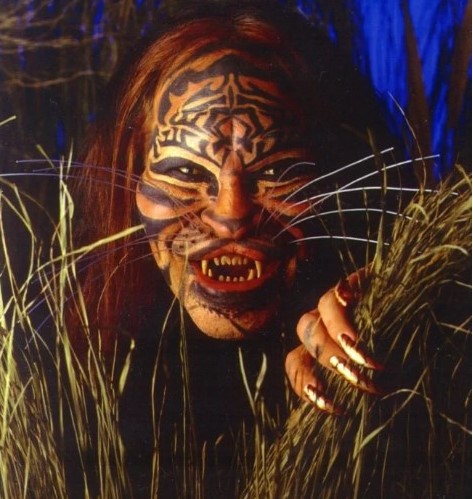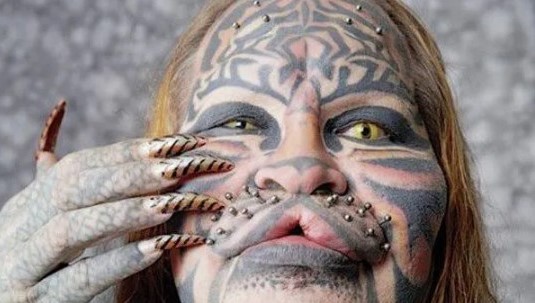Do you remember seeing a man who looked strikingly like a feline on TV shows in the early 2000s? His appearance often stirred conversation, curiosity, and sometimes disbelief. That man was Dennis Avner, an American who committed his life to transforming his physical appearance in a way that few others ever have. His goal? To resemble a tiger—not simply as a matter of aesthetics, but as a spiritual expression deeply rooted in his personal beliefs and heritage.

Dennis Avner was born in Michigan and worked as a computer programmer. However, his unique story extends far beyond technology. He was of Native American descent, tracing his roots to the Huron and Lakota tribes. His tribal heritage played a significant role in shaping his identity and life choices. Among his cultural and spiritual beliefs was the concept of a totem animal—a symbolic creature that represents a person’s spirit or guides their life. For Avner, that animal was the tiger. While tigers are not native to North America and aren’t traditional totem animals in his ancestral tribes, he chose the feline symbol as a personal spiritual path, blending cultural ideas in a way that was meaningful to him.

In accordance with his beliefs, Dennis adopted the totemic name “Stalking Cat,” which he preferred people use when referring to him. Despite this, the media often referred to him as “Cat Man,” a moniker that, while catchy, failed to fully capture the spiritual intent behind his transformation. Stalking Cat wasn’t simply trying to look like an animal for shock value or attention—he viewed the transformation as a lifelong journey of self-discovery and spiritual alignment.

To achieve his tiger-like appearance, Avner underwent an extensive series of body modification procedures. These were not just minor cosmetic changes; they were significant and, in many cases, irreversible. Some of the modifications included splitting his upper lip to resemble the mouth of a feline, reshaping his ears, altering his nose, and extensively tattooing his face and body with patterns meant to mimic a tiger’s stripes. He also had subdermal implants that changed the contours of his face and forehead, creating a more angular, animalistic structure.

One of the more distinctive features of his appearance was his dental work. He had his teeth filed and capped to resemble fangs, enhancing the illusion of a feline predator. He also wore custom-made contact lenses that gave his eyes a vertical slit-like pupil, resembling those of a cat. Furthermore, whisker-like prosthetics were attached to his upper lip using piercings, which added yet another layer to his transformation. Even his nails were shaped and decorated to mimic claws. He sometimes wore a tail and adopted feline gestures and postures in his daily life.
Over the years, Stalking Cat gained considerable media attention. His appearance made him a fascinating figure to talk show hosts and documentary producers. He was featured on various TV programs and in numerous interviews, often portrayed as both enigmatic and eccentric. While some viewers were taken aback by his appearance, others were intrigued by his commitment and the deeper meanings behind his transformation. For Avner, however, the surgeries and modifications were never about spectacle—they were about spiritual growth and personal truth. In interviews, he often explained that he was following “an ancient tradition,” and that his journey was not something he took lightly.

Interestingly, Dennis Avner never revealed how much money he had spent on his transformation. When asked, he would often dismiss the question, stating that the spiritual value far outweighed any financial cost. He emphasized that his journey was about becoming more in tune with his spirit and nature, not about making headlines or gaining fame.
Finding images of Stalking Cat before his transformation is remarkably difficult. He went to great lengths to keep his original appearance private, reinforcing his desire to be known and seen only as Stalking Cat. However, a few rare photos from his childhood reveal a boy with soft features and gentle eyes—someone who, like many of us, likely had no idea where life would eventually take him.

Sadly, Dennis Avner’s story also has a somber conclusion. In 2012, he passed away at the age of 54. His death sparked discussions about mental health, body modification, and identity. For some, he remains a symbol of extreme transformation; for others, he represents a profound personal journey to live authentically, no matter how unconventional it may appear.
Stalking Cat’s life challenges us to think more deeply about identity, spirituality, and the lengths to which individuals will go to express their innermost truths. Whether one sees his transformation as art, devotion, or something else entirely, it’s clear that Dennis Avner was a man who lived—and transformed—on his own terms.